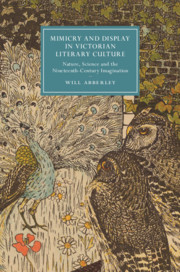 Mimicry and Display in Victorian Literary Culture
Mimicry and Display in Victorian Literary Culture Adaptive Appearance and Cultural Theory
Published online by Cambridge University Press: 16 May 2020
The Conclusion reflects on the implications of the study’s findings for future research, particularly in cultural theory. Victorian adaptive appearance is considered as a discourse that in certain ways prefigured the works of Charles Sanders Peirce and Jakob von Uexküll, and more recent theorisations of biosemiotics and zoosemiotics. The study shows that contemporary concepts of non-human and cross-species semiosis are less new than they may seem. However, it also problematises post-humanist celebrations of the supposed collapsing of the human/non-human binary. Similarly, the study shows that biosemiotic thinking does not necessarily align with progressive politics, as is sometimes assumed. As a cultural trope, adaptive appearance could both undermine and reinforce essentialist views of identity. It is suggested that the study’s discussions of visibility, recognition and appearance signpost new ways of approaching the politics of the gaze and the ideological stakes of female visibility. Some hints are offered on how researchers might explore the afterlives of adaptive appearance in twentieth-century science and culture. The chapter also notes how adaptive appearance has featured in retrospective fictive depictions of Victorian society and culture. Finally, parallels are suggested between Victorian adaptive appearance and current representations of environmental crisis.
To save this book to your Kindle, first ensure [email protected] is added to your Approved Personal Document E-mail List under your Personal Document Settings on the Manage Your Content and Devices page of your Amazon account. Then enter the ‘name’ part of your Kindle email address below. Find out more about saving to your Kindle.
Note you can select to save to either the @free.kindle.com or @kindle.com variations. ‘@free.kindle.com’ emails are free but can only be saved to your device when it is connected to wi-fi. ‘@kindle.com’ emails can be delivered even when you are not connected to wi-fi, but note that service fees apply.
Find out more about the Kindle Personal Document Service.
To save content items to your account, please confirm that you agree to abide by our usage policies. If this is the first time you use this feature, you will be asked to authorise Cambridge Core to connect with your account. Find out more about saving content to Dropbox.
To save content items to your account, please confirm that you agree to abide by our usage policies. If this is the first time you use this feature, you will be asked to authorise Cambridge Core to connect with your account. Find out more about saving content to Google Drive.